Seeing Things: February 2008 Archives
This article originally appeared in the Culture section of Bloomberg News on February 29, 2008.
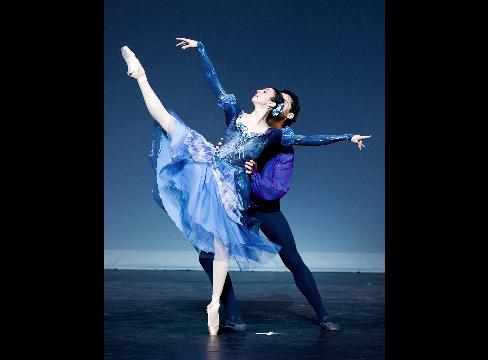
Nina Ananiashvili and Vasil Akhmeteli perform in Alexei Ratmansky's "Bizet Variations" at a dress rehearsal at the Brooklyn Academy of Music (BAM) Howard Gilman Opera House in the Brooklyn borough of New York on Feb. 26, 2008. Performances by the State Ballet of Georgia will continue at the BAM through March 2. Photographer: Jack Vartoogian/FrontRowPhotos/BAM via Bloomberg News
Feb. 29 (Bloomberg) -- The State Ballet of Georgia, on the New York leg of a U.S. tour, presents finely trained bodies and a lesson in how scrupulous correctness squelches the lushness and risk needed for top-notch dancing.
The delightful moments of Wednesday night's performance stemmed almost entirely from the artistic director, Nina Ananiashvili. In a mostly pallid rendering of George Balanchine's ``Chaconne,'' she stood out in demonstrating that clarity and expression can work together.
No doubt the company is showing itself in major venues too soon. Fresh from a stint in Los Angeles, it is currently at the Brooklyn Academy of Music through March 2 and then heads for Chicago. It would probably sell few tickets without the incomparable Ananiashvili in starring roles.
The rest of the company isn't without merit. Since Georgia's president, Mikhail Saakashvili, invited the ballerina to run it in 2004, she has brought new vigor -- in both technique and repertory -- to a troupe that had been languishing.
After ``Chaconne,'' the company did Balanchine's ``Duo Concertant.'' The performance still suffered a little from letter-of-the-law adherence to the choreography, but it received some robust grace from its two dancers, Nino Gogua and, especially, Lasha Khozashvili.
``Bizet Variations,'' commissioned from Alexei Ratmansky, artistic director of the Bolshoi Ballet, is merely a bagatelle, but it's a lovely one. As a choreographer, Ratmansky is like a friend whose conversation is always interesting, invariably filled with insights into human relationships.
Three Couples
Set to the composer's ``Chromatic Variations,'' the piece is formally a sextet for three couples. Actually, it's a vehicle for Ananiashvili, meant to show her as the most delightful woman in the world, a part she plays here to perfection.
Without challenging her technique unduly, it shows her first as flirtatious, although democratically so, then utterly committed to her main partner, Vasil Akhmeteli. Throughout, she grows increasingly sweet, tender and charming, like a rose coming into bloom. The dance even gives her a moment of plangent secret sorrow, as if to cut any tendency toward the saccharine or, perhaps, to make her seem more real.
``Sagalobeli,'' by Yuri Possokhov, a Bolshoi alumnus now the San Francisco Ballet's resident choreographer, provided the obligatory send-'em-home-happy closer. It's set to traditional Georgian folk music, delivered live and wonderfully by an ensemble clad in black and silver uniforms worthy of grand officials in long-ago and faraway lands.
The choreography wasn't anywhere near so appealing. It attempts to combine ballet basics with supposedly ethnic moves. The men gave the material assigned to them a rough-hewn relish; the women, a sultry grace.
Few Stars
The piece went on and on, revealing that even the most competent dancers in the troupe don't include more than one or two nascent stars and that too many of the performers lack the sculptural dimension so necessary to their calling. Ananiashvili no doubt serves as a superb role model for them, but no one comes close to matching her talents. International recognition for the company looks to be at least a decade away.
Ananiashvili is probably nearing the end of her performing career. She was born in 1963. Like Balanchine, she is a native of Georgia, which won its independence from the former Soviet Union in 1991. Trained at the academy of Moscow's Bolshoi Ballet, she subsequently became a revered principal dancer with the company and a guest star worldwide.
Exquisitely proportioned, with a soulful face, technically pure and musically sensitive, Ananiashvili invariably infuses each role she plays with an affecting back story. She has been unusually receptive to choreography vastly different in style from the one in which she was bred and has an almost mystical affinity for Balanchine's works. With her dancing days drawing to a close, nurturing the Georgian company may provide the best future for all concerned.
The State Ballet of Georgia is at the BAM Howard Gilman Opera House, 30 Lafayette Ave., Brooklyn, through March 2. Information: +1-718-636-4100; http://www.bam.org.
© 2008 Bloomberg L.P. All rights reserved. Reprinted with permission.
This article originally appeared in the Culture section of Bloomberg News on February 23, 2008.
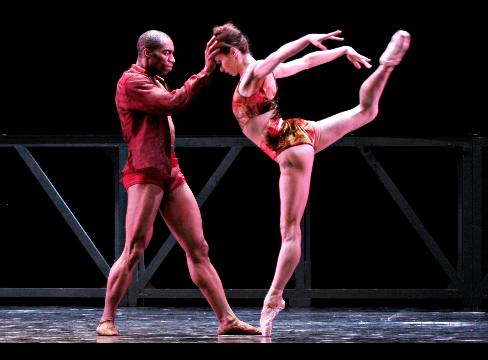
Desmond Richardson, left, and Diana Vishneva rehearse for "Diana Vishneva: Beauty in Motion" in New York on Feb. 13, 2008. Performances will be held at the Manhattan City Center through Feb. 24. Source: Helene Davis PR via Bloomberg News
Feb. 23 (Bloomberg) -- Even the curtain call was costumed, the ballerina wearing a gleaming black gown cut Victorian style but slashed to reveal bare skin and cradling in her arms an extravagant sheaf of calla lilies.
``Diana Vishneva: Beauty in Motion,'' at Manhattan's City Center through Sunday, was devised by the same folks who concocted the disappointing ``Kings of the Dance.'' Like that earlier venture, this glitzy showcase for the phenomenally accomplished Kirov ballerina appears to be mainly focused on exploiting the star's box office appeal.
The program takes the novelty route, with three ballets commissioned for Vishneva that are pointedly unlike the material she dances with her home company or with American Ballet Theater, with which she now performs every spring at the Metropolitan Opera House.
Dwight Rhoden, who heads the Complexions Dance Company, provided the most striking piece, ``Three Point Turn.'' It explores the theme of fraught love as athletically as can be imagined. Vishneva and Desmond Richardson, who might be called Rhoden's muse, are backed up by two other couples, at first more innocent and dreamy, then infected by the savage extremes set by the main pair.
Initially Vishneva and Richardson embrace, kiss and make gestures of submission and tenderness. Then they proceed, at inordinate length, to beat the hell out of each other. They finish on a note of unexpected conciliation -- a hard-won happy ending. Maybe 20-somethings will see themselves in this mirror.
Black Light
Moses Pendleton, who directs Momix, a Pilobolus spinoff, created ``F.L.O.W. (For Love of Women),'' which presents Vishneva in three gimmick-driven guises. In the first segment, she's unrecognizable, one of three women animating black-light effects in which undulating limbs seem to float like swans on a lake or skeletons come unhinged.
Next we get the ballerina alone, wearing only a flesh- tinted leotard, bathed in a golden glow as she lies on a large mirrored platform tilted toward the audience. Hints that the figure is making love to herself take narcissism to a new dimension. Finally, in another solo, Vishneva sports a cage of bead chains that fall from her head to the floor or swirl around her as she turns.
Protean Quality
Surely Vishneva's protean quality is better revealed in her customary repertory, which has an extraordinarily wide range -- from her tragic Juliet (in the Kenneth MacMillan version of the classic) through her jazzy ballerina in Balanchine's scintillating ``Rubies.''
``Pierrot Lunaire'' -- choreographed to the Schoenberg song cycle by Alexei Ratmansky, artistic director of the Bolshoi Ballet -- is by far the show's most intelligent item. It's a postmodern take on commedia dell'arte. Granted it lacks the traditional knockabout plot and Harlequin figure. Still, it boasts not one but three Kirov men as Pierrot, moonstruck, the eternal clown and visionary, miming in the grotesque commedia style but dancing classically.
Vishneva is a charming Columbine type, a marvel of technical exactitude and mercurial moods. The two big drawbacks to the piece? Vishneva -- the woman who can do everything -- lacks soul, and Ratmansky is not quite up to the strange beauty of the music.
Even if the commissioned ballets were more worthy, and even though Vishneva's skill and versatility are remarkable, the program proves that a ballerina is most potent in the context of a full company -- at best, her own, from which her style springs, or a least an institution of the same caliber.
Through Feb. 24 at 131 W. 55th St. Information: +1-212-581- 1212; http://www.nycitycenter.org.
© 2008 Bloomberg L.P. All rights reserved. Reprinted with permission.
New York Theatre Ballet / Florence Gould Hall, NYC / February 8-9, 2008
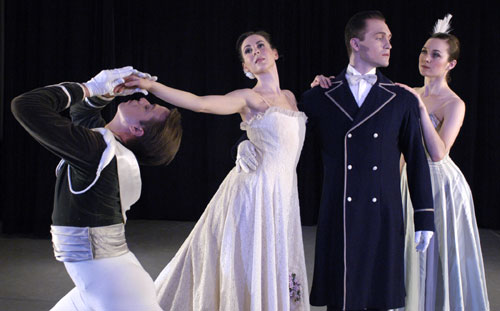
Members of the New York Theatre Ballet in Antony Tudor's Jardin aux Lilas. Photo by Richard Termine.
Antony Tudor's Jardin aux Lilas reveals the vagaries of the human heart through impassioned rushes through the space (as if it were an invisible maze constructed by Fate), furtive meetings, whispered secrets, brief touches, gestures of unfulfilled yearning, and cruel ones of possession. At a celebrated point, all the members of the cast freeze in postures indicating their relationships, as if paralyzed by the intensity of the emotions they're feeling, while the music surges on.
The full article appeared in Voice of Dance (http://www.voiceofdance.org) on February 15, 2008. To read it, click here.
This article originally appeared in the Culture section of Bloomberg News on February 8, 2008.
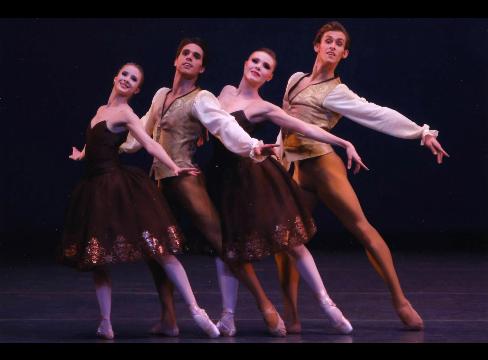
Ballet dancers, from left, Sterling Hyltin, Giovanni Villalobos, Sara Mearns, and Adrian Danchig-Waring perforn in the New York City Ballet production of "Rococo Variations" in New York. Photographer: Paul Kolnik/NYCB via Bloomberg News
Feb. 8 (Bloomberg) -- ``Rococo Variations,'' set to Tchaikovsky's ``Variations on a Rococo Theme,'' is Christopher Wheeldon's final offering as the New York City Ballet's resident choreographer. He relinquished the position, created for him in 2001, to concentrate on his own small troupe, Morphoses/The Wheeldon Company.
The premiere last night, at New York's Lincoln Center, revealed an intimate quartet, at once sweet and strange. The ballet looks both to the past and to the future. Two couples -- Sterling Hyltin and Giovanni Villalobos, Sara Mearns and Adrian Danchig-Waring -- friends who double-date, exude a faint perfume from the Rococo era early in the piece, with their ornate, formal behavior, even in the cut of the ladies' aubergine, gilt-edged skirts. As if part of a long-ago social dance, they mirror each other or perform complementary moves.
Yet soon oddities creep in. The unexpected intrudes upon the conventional, often in midphrase. This aspect of the choreography, typical of Wheeldon, works well here, reflecting the small vagaries of love even in ostensibly compatible couples. Characteristic of Wheeldon too is his having the dancers use the floor the way modern dancers do -- as an element familiar as the air that classical ballet usually favors. Lifts, though rare, become offbeat and startling, almost deliberately peculiar.
In Tchaikovsky's seventh and final variation, the sole extended allegro passage in the score, Wheeldon gives his four dancers more conventional choreography than anything that preceded it. They perk up and behave as if their relationships had no subtext whatever, as if love could be simple and perfect.
``Rococo Variations'' is a pleasant, if minor, affair, ravishingly performed.
Nikolaj Hubbe
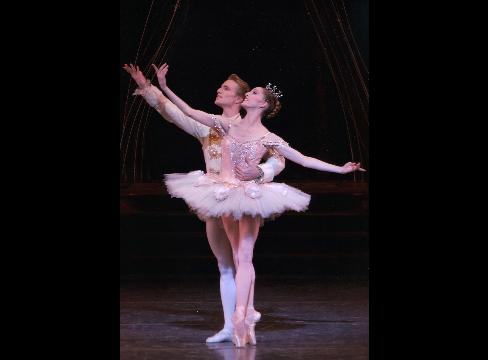
Wendy Whelan, as Princess Aurora, right, and Nikolaj Hubbe as Prince Desire perform in "The Sleeping Beauty," produced by Peter Ilyitch Tschaikovsky, at the New York City Ballet. Photographer: Paul Kolnik. Source: New York City Ballet via Bloomberg News
City Ballet is preparing a major sendoff for principal dancer Nikolaj Hubbe, who gives his final performance at Sunday's matinee. Tickets are sure to be scarce, the cheers and tears no doubt copious. This is only fitting when a unique artist retires from the stage. Hubbe goes on to a terrific job as artistic director of the Royal Danish Ballet, which bred him.
His daring imagination, bolstered by buoyant technique, has no equal, and its absence from the City Ballet will leave a discernible void.
Born in Copenhagen in 1967, Hubbe rose to the highest rank of the Royal Danish Ballet at the precocious age of 20. Like many of Denmark's superb male dancers before him -- among them, Peter Martins, who now heads the City Ballet -- Hubbe responded to the siren song of the Balanchine and Robbins repertory and the thrill of New York itself, joining the company as a principal in 1992.
Potent Actor
From the very start of his career, Hubbe was as potent an actor as he was a notable classical dancer. People still talk about his unforgettable guest performance with the Danes as the hero, James, of ``La Sylphide,'' opposite Sorella Englund, a character dancer whose talents match his, as the witch who is his undoing. Their interaction was so deeply intimate and emotionally turbulent that it seemed to go beyond theatrical boundaries. You sat there thinking maybe the police should be called in.
When Hubbe's athletic prowess ebbed with age, his imaginative gift came even more to the fore. Just a few weeks ago, playing The Poet in Balanchine's ``La Sonnambula,'' he cast aside the conventional interpretation of the role. Instead of being the innocent visionary corrupted by an evil society, he treated both the loose woman and the angelic (perhaps ghostly) one he encounters as objects of his sensual hunger. This maverick portrayal offered the most intense and believable drama I've seen in years on the City Ballet stage.
Hubbe will dance four of the five items on his farewell program: Balanchine's landmark neoclassic ballet ``Apollo''; ``Zakouski,'' a lively bagatelle choreographed for him by Martins; ``Cool,'' from Robbins's ``West Side Story Suite'' (in which he also sings); and the rakish final section of Balanchine's ``Western Symphony.'' A very young, very promising pair will offer the enchanting ``Flower Festival'' duet by Denmark's August Bournonville -- a heartfelt tribute to Hubbe's roots as he returns to them.
New York City Ballet performs through Feb. 24 at the New York State Theater, Lincoln Center, Broadway at 65th Street. Information: +1-212-721-6500; http://www.nycballet.com.
© 2008 Bloomberg L.P. All rights reserved. Reprinted with permission.
This article originally appeared in the Culture section of Bloomberg News on February 7, 2008.

Alexei Ratmansky, artistic director of the Moscow-based Bolshoi Ballet, performs in this undated handout image. Photographer: Vyacheslav Podorozhy/NYCBallet via Bloomberg News
Feb. 7 (Bloomberg) -- Alexei Ratmansky, artistic director of the Moscow-based Bolshoi Ballet, is scheduled to meet this weekend with Peter Martins, his counterpart at the New York City Ballet. The tete-a-tete, confirmed by the City Ballet, is likely to determine whether Ratmansky will succeed Christopher Wheeldon as resident choreographer with the New York company.
The answer looks like yes. The offer was initially made in March 2007. Last month Ratmansky told an interviewer from the Russian newspaper Izvestia that he will resign from the Bolshoi when his contract expires at the end of this year, in order to devote himself to choreography.
Martins's wise offer -- Ratmansky is the strongest candidate -- can also be read as ironic revenge on Wheeldon, for whom the post was created in 2001. Wheeldon leaves this season, preferring to focus his energies on his own new, chamber-size troupe, Morphoses/The Wheeldon Company. (The troupe made its New York debut in October, to mixed reviews.)
Ratmansky is far from a great choreographer, but he's a gifted and warm-hearted one who expresses genuine feeling in his dances. His 2006 creation for City Ballet, ``Russian Seasons,'' was engaging, intelligent and filled with a sense of real human life.
By contrast, Wheeldon's abstract ballets, while astutely crafted, tend to be emotionally frozen or distanced; his narrative pieces are washed with sentiments that don't ring true.
Circuitous Route
Ratmansky's career has taken a circuitous route. Born in St. Petersburg, he trained at the Bolshoi's school but was rejected for the celebrated company. He then danced with the Ukrainian National Ballet, the Royal Winnipeg Ballet and the Royal Danish Ballet. Along the way he choreographed and confirmed his dance-making talent with the joyous, entertaining ``The Bright Stream'' for the Bolshoi even before the company appointed him to the top post.
Now it looks as if Ratmansky will be the one every company wants to commission, as it was with predecessors Wheeldon and Jorma Elo, a specialist in the Frenetic School of choreography.
City Ballet will present another new Ratmansky piece during its 2008 spring season. Before that, his work will be seen in ``Diana Vishneva: Beauty in Motion,'' for which he has created a ``Pierrot Lunaire'' to the Schoenberg song cycle, for the versatile Kirov Ballet star. (The show runs Feb. 21-24 at City Center.)
Bolshoi ballerina Nina Ananiashvili's State Ballet of Georgia will then offer two Ratmansky pieces, ``Bizet Variations'' and ``Dreams About Japan,'' at the Brooklyn Academy of Music (Feb. 27-March 2).
Wheeldon offers a cautionary tale to the dance press, which built him up, exaggerating his gifts, desperate to discover and tout a successor to Balanchine. They turned on him when, inevitably, he disappointed, especially when he offered programs featuring his own pieces back-to-back.
Ratmansky deserves more restrained treatment. Choreographic genius is rare; if he does sign on with City Ballet, Ratmansky may prove that good can be good enough indeed.
© 2008 Bloomberg L.P. All rights reserved. Reprinted with permission.
Sitelines
AJ Ads
 360° Dance Company at DTW offers two socially relevant revivals, Jane Dudley’s solo “Time Is Money” (1932) and Mary Anthony’s “Devil in Massachusetts” (1952) as well as the World Premier of Artistic Director, Martin Lofsnes' "6-1".
360° Dance Company at DTW offers two socially relevant revivals, Jane Dudley’s solo “Time Is Money” (1932) and Mary Anthony’s “Devil in Massachusetts” (1952) as well as the World Premier of Artistic Director, Martin Lofsnes' "6-1".
AJ Blogs
AJBlogCentral | rssculture
Terry Teachout on the arts in New York City
Andrew Taylor on the business of arts & culture
rock culture approximately
Laura Collins-Hughes on arts, culture and coverage
Richard Kessler on arts education
Douglas McLennan's blog
Dalouge Smith advocates for the Arts
Art from the American Outback
Chloe Veltman on how culture will save the world
For immediate release: the arts are marketable
No genre is the new genre
David Jays on theatre and dance
Paul Levy measures the Angles
Judith H. Dobrzynski on Culture
John Rockwell on the arts
innovations and impediments in not-for-profit arts
Jan Herman - arts, media & culture with 'tude
dance
Apollinaire Scherr talks about dance
Tobi Tobias on dance et al...
jazz
Howard Mandel's freelance Urban Improvisation
Focus on New Orleans. Jazz and Other Sounds
Doug Ramsey on Jazz and other matters...
media
Jeff Weinstein's Cultural Mixology
Martha Bayles on Film...
classical music
Fresh ideas on building arts communities
Greg Sandow performs a book-in-progress
Harvey Sachs on music, and various digressions
Bruce Brubaker on all things Piano
Kyle Gann on music after the fact
Greg Sandow on the future of Classical Music
Norman Lebrecht on Shifting Sound Worlds
Joe Horowitz on music
publishing
Jerome Weeks on Books
Scott McLemee on books, ideas & trash-culture ephemera
theatre
Wendy Rosenfield: covering drama, onstage and off
visual
Public Art, Public Space
Regina Hackett takes her Art To Go
John Perreault's art diary
Lee Rosenbaum's Cultural Commentary
